Geraniums are Easy Care Summer Darlings
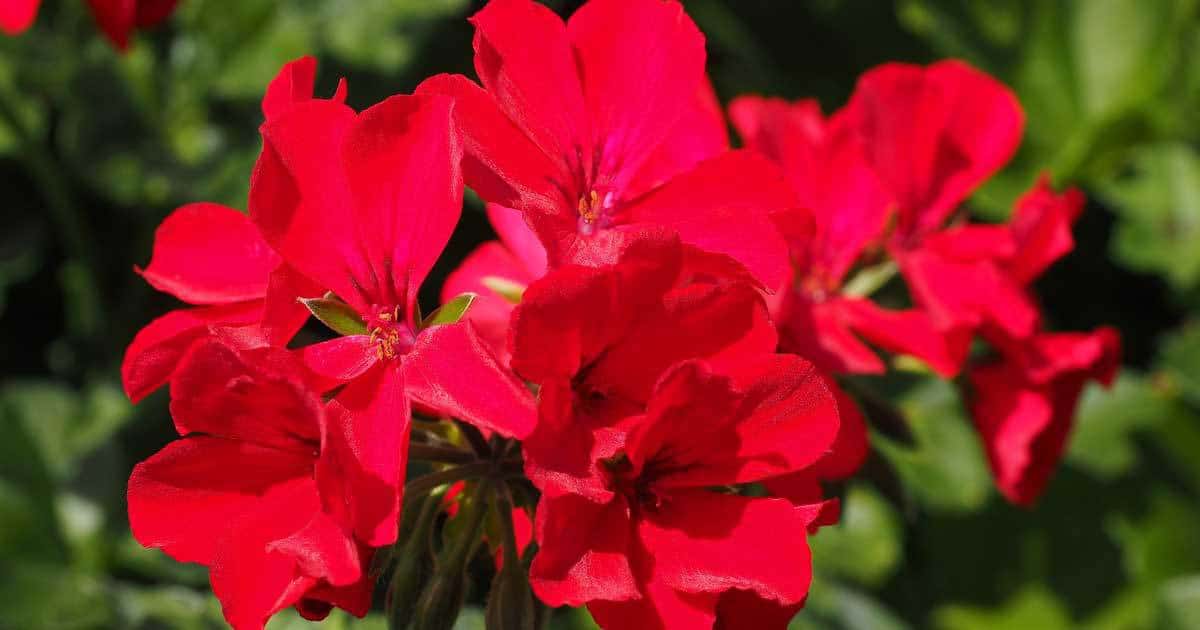
Geraniums (Pelargonium species) are widely used and very popular as garden and container annual plants all over the world. Their appeal arises from their magnificent masses of blooms that look fantastic from summer until winter; their ‘easy to care for’ simplicity of maintenance; and the availability of thousands of varieties that create a stunning colours and patterns. In most zones, geraniums are considered an annual plant, but in warmer zones – usually zones 10 and 11, depending on the variety – they can be grown as a perennial.
Geranium Plants – What’s The Difference?
There are two types of plants that most people refer to as “geraniums”.
Quick Growing Guide
Botanical Name: Geranium Pelargonium and over 400 species
Genus: Geranium
Also Called: Pelargonium, storkbill, cranesbill
En français: Géranium, Pélargon, Pélargonium
Sun / Shade:
Water: Water in the morning for hydration for the whole day
Soil:
Height:
Care:
- The “true geraniums”, which are hardy, native and wild plants that make excellent groundcover and space filler in your garden and landscape.
- The Pelargoniums, which are more delicate plants, hail from South Africa.
Both of types of the geranium produce a large number of cultivars and are frequently mistaken.
- The flower‘s form is the simplest way to distinguish Pelargonium species from Geranium species. Pelargonium flowers are bilaterally zygomorphic (the corolla has a single plane of symmetry, with two mirrorimage halves), whereas Geranium blooms are actinomorphic (the corolla is radially symmetric, with five petals arrayed starlike).
- Geranium seeds are typically flung away by an explosive mechanism, but Pelargonium seeds float away on the breeze thanks to a feathery end (lacking in Geranium).
- The foliage of cultivated Geranium species is frequently more divided than that of cultivated Pelargonium species.
- Unlike cultivated Geranium species, Pelargonium has thick, succulent stalks.

Geranium and Pelargonium used to be in the same genus, Geranium. However, they were split into two genera in 1789. True geraniums are also known as hardy geraniums, perpetual geraniums, and cranes-bill geraniums (because of the shape of their seed pods).
These native or naturalised plants grow low to the ground and spread rapidly and easily by rhizomes. The leaves of hardy geraniums vary depending on the variety, but they are often serrated and very lush and appealing. Flowers in blue, purple, magenta, pink, and white are delicate.
Hardy geraniums are not as huge as their Pelargonium relatives. They are, however, considerably tougher and can thrive in a wider range of conditions. They produce an abundance of gorgeous blooms and grow so quickly that they may be used as a ground cover. The flowers of hardy geraniums are modest but highly lovely. Their leaves range in size from relatively little (dime-sized) to fairly enormous. In many respects, the resilient geranium is a considerably more intriguing addition to your garden than the African Pelargonium. It may be cultivated all year in zones 8-10, with heights ranging from five inches to three feet.
Hardy geraniums are herbaceous perennials with silky stems that make a fantastic accent to any garden. They are an excellent choice for borders and filling in gaps since they are strong and hardy and resistant to most diseases and pests. In the winter, they go dormant, and in the spring, they sprout new leaves. As a result, most cultivars can withstand temperatures as low as -20 degrees Fahrenheit (-30C).
Growing True Geraniums
Hardy geraniums are basically wildflowers, so they don’t require much attention. True geraniums require a well-drained, fertile, and wet bed to thrive. Some real geraniums may be planted from seed, but identified cultivars must be started from cuttings. This is best done in the early spring.
If you do not get much rain in the summer, you’ll need to water deeply once a week. Mulching around the roots is helpful in areas where the summer is quite hot and dry because it helps keep roots moist.
Because these attractive tiny plants grow in an unruly manner as wildflowers, you may want to cut them once throughout the growth season. Make careful to leave at least two or three inches of stem above the surface of the soil while pruning. If you reside in the deep South, where there is a lot of summer humidity and heat, you may have trouble producing even the hardiest geraniums due to a mould and mildew problem. Midseason trimming will assist since it will allow for better air circulation.
Varieties Of Geranium
Geranium macrorrhizum is a perennial plant endemic to the Balkans and the Southeast Alps. Rock cranesbill, bigroot geranium, and Bulgarian geranium are other names for it. Although mostly grown as a decorative plant, geranium macrorhizums also has antibacterial characteristics that are useful in traditional medicine and aromatherapy.
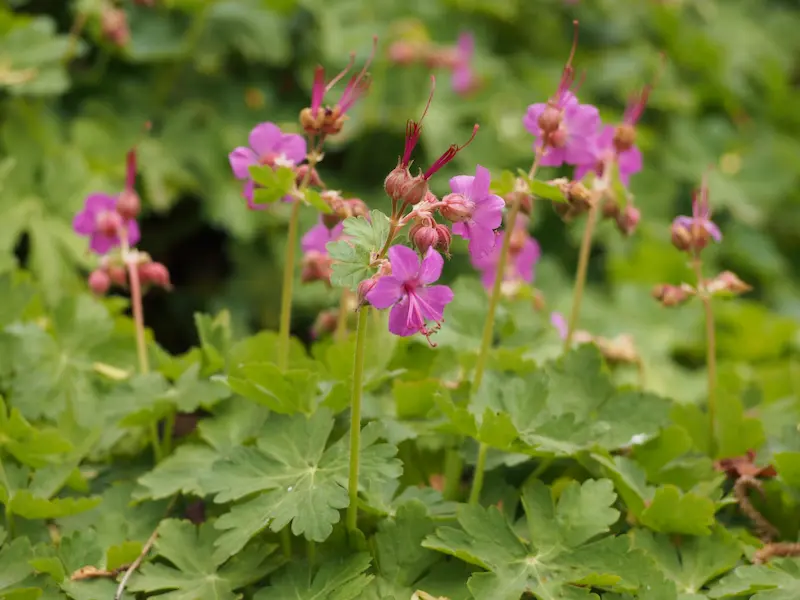
Credit: Agnieszka Kwiecień, Nova, CC BY-SA 4.0 https://creativecommons.org/licenses/by-sa/4.0, via Wikimedia Commons
Pelargonium x hortorum is also known as zonal geranium, zonal pelargonium or garden geranium. This species is easy to grow and can be propagated at home through cuttings. Gardeners grow this to become a beautiful ornamental plant.

Credit: Forest & Kim Starr, CC BY 3.0 https://creativecommons.org/licenses/by/3.0, via Wikimedia Commons
Geranium cantabrigiense is another herbaceous perennial of the geraniaceae family with a common name of hardy geranium. It grows easily in a variety of habitats, attracts butterflies, and tolerates deer and rabbits.

Credit: Krzysztof Ziarnek, Kenraiz, CC BY-SA 4.0 https://creativecommons.org/licenses/by-sa/4.0, via Wikimedia Commons
Geranium maderense is also known as Madeira cranesbill as it’s native to the Madeira island in Portugal. This evergreen perennial grows spectacular pink flowers and divided ferny leaves.
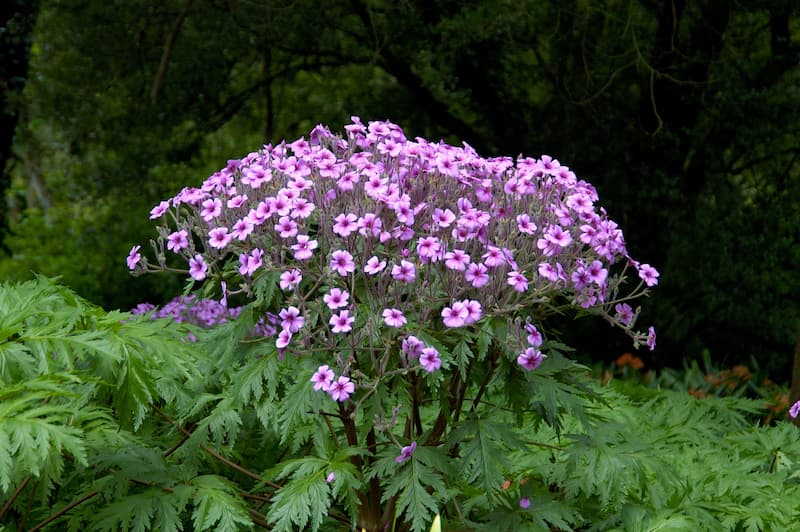
Credit: Eric Hunt, CC BY-SA 2.5 https://creativecommons.org/licenses/by-sa/2.5, via Wikimedia Commons
Geranium rozanne or Rozanne geranium is a perennial plant that can grow through many climatic conditions. It is low maintenance and resistant of pets and many diseases.
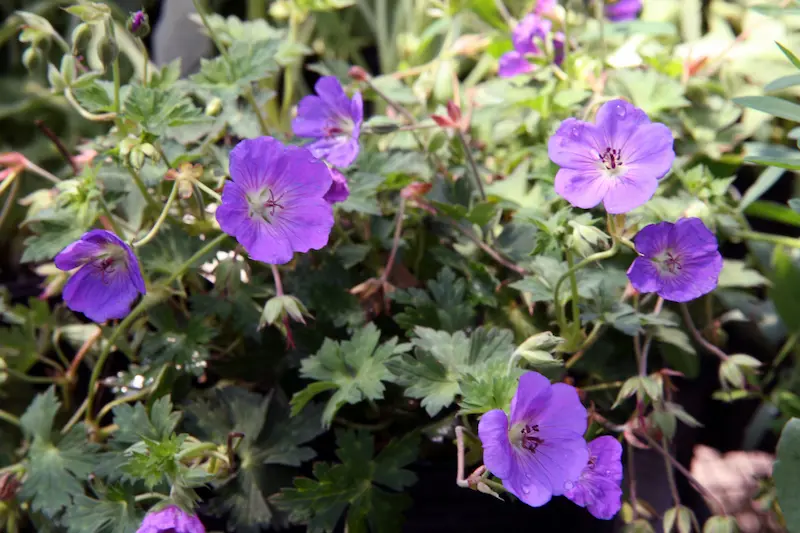
Credit Photo by David J. Stang, CC BY-SA 4.0 https://creativecommons.org/licenses/by-sa/4.0, via Wikimedia Commons
Geranium Care: Sunlight Requirements Vary
Your true geraniums will thrive if you place them in a bed that receives either morning or afternoon sun. Full sun all day long is a bit too much. Many do well in shady areas. For example the Coast Wildflower variety (Geranium maculatum) does very well in cool places with deep shade.
This delicate appearing, yet tough wildflower provides a touch of color to shaded areas with its fairly large light pink flowers.
Other varieties that do well in shade include Geranium endressii, which is also known as Wargrave Pink and Geranium nodosum, which has rather shiny leaves and pretty funnel shaped flowers that range from pale lilac to a fairly dark shade of pink. Geranium phaeum is another good choice for cool dark places. You may know this type of wild geranium as Samobor. It has dark green leaves with maroon flowers.
There is another variety known as Album, which has variegated leaves and white flowers. Finally, the variety of true geranium that provides the most choices is Geranium oxonianum which is available in a whopping 34 named varieties. Some of the best choices include:
- AT Johnson
- Phoebe Nobel
- Winscombe
- Walter’s Gift
All of these will thrive in partial to deep shade. For best results, prune enthusiastically during midseason to encourage new growth.
Using True Geraniums In Your Landscape
Ground Cover:
The two best varieties of true geranium for use as ground cover are:
- Ingwersen’s which has a scent reminiscent of pine and balsam and produces delicate pink flowers
- Czakor which produces bold flowers that are deep magenta in color.
These two types are very hardy and aggressive and have strong weed-smothering qualities. In milder regions, they will stay green all year round. Both of these are hardy in zones 3-9.
Containers and Rock Gardens:
True geraniums are an excellent choice in containers or in rock garden. Ballerina is especially suited this purposes. This variety is hardy in zones 4-9. It produces large, showy pale lavender flowers that have contrasting burgundy veins. The leaves are an interesting and pleasing ash gray tone. Another good choice for containers or rock gardens is Nigricans, which is hardy in zones 8-10. This plant produces small, white flowers.
Perennial Borders:
For bright sunny locations, Cedric Morris is a great choice in true geraniums. It is quite showy with large leaves and pale magenta flowers. For contrast, you might want to also include the white strain of this variety. It’s flowers are bit larger.
Growing Geranium Pelargonium
Pelargonium blooms are delightful home and garden plants that are simple to grow and maintain. Pelargoniums are very popular as both indoor and garden plants. Many varieties do quite well in hanging baskets. They are available in a broad range of flower varieties and colours. They flourish outside all year if you reside in a temperate zone. If you reside in a freezing environment, you must supply them with winter protection.
Pelargoniums are South African cousins of true geraniums. These are the plants you will find most often in your local nursery or home improvement center. Pelargoniums are available in many different varieties. Some popular types that fall under the heading of Pelargonium include, Lady Washington Geranium, Scented Geraniums, and Ivy Geranium, pictured here.

Credit: Edward H. Mitchell, Public domain.
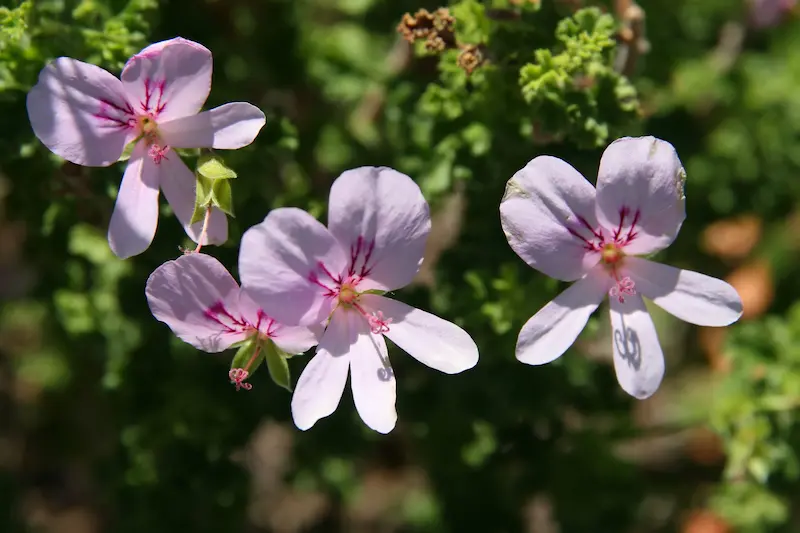
Photo by David J. Stang, CC BY-SA 4.0 https://creativecommons.org/licenses/by-sa/4.0, via Wikimedia Commons

Credit cultivar413 from Fallbrook, California, CC BY 2.0 https://creativecommons.org/licenses/by/2.0, via Wikimedia Commons
How To Care For Pelargoniums
The needs of these types of geranium are quite specific; however, once you understand them you will have no problem growing the plants that are known as common geraniums.
They are relatively hardy and adaptable as long as their needs are met. Their needs vary depending upon the setting and the results you desire. For example, if you are growing geraniums indoors they’ll do all right in moderate light. However, if you want abundant blooms you will need to provide a great deal of light. Six to eight hours a day is best.
Indoors, geraniums like a temperature ranging from 65-70 degrees Fahrenheit during the daytime and about 55° degrees Fahrenheit overnight.
To do their very best outdoors, all African geraniums must have a great deal of sunlight. Six hours a day is the minimum. Some types, such as Regal and Martha Washington varieties, prefer afternoon shade in all circumstances. If temperatures in your area get higher than 90 degrees Fahrenheit, all types of geraniums need afternoon shade.
Well-drained soil is a must for geraniums in any setting. They should be planted in a light potting mix consisting of approximately 1/3 soil, 1/3 peat moss and 1/3 perlite.
Planting Geraniums Outdoors
Because Pelargoniums do hail from South Africa, they cannot tolerate freezing temperatures. If you are going to grow these types of geraniums outdoors in a non-temperate area, you should not put them in place until all danger of frost has passed. Prepare the bed well for good drainage and place your plants about 8″ to 12″ inches apart. Mulch around them heavily to help the roots retain moisture.
Planting And Caring For Pelargoniums Outdoors
- Be sure to establish your geranium bed in an area that receives a minimum of six hours of sunlight daily. In very hot areas, morning sun and afternoon shade are preferable.
- Till the soil thoroughly to a depth of about 10 inches. Test your soil to be sure that it is slightly acidic. Geraniums like a pH level of approximately 6.5.
- Amend your soil as needed to attain this level. Good additions to the soil include compost and well-rotted manure. Your soil should be light and provide good drainage.
- When planting your geraniums, be sure not to bury the stems more deeply than the original soil level as doing so will encourage rot. Once your plant is in place press the soil down firmly around its base. Mulch generously.
- Once all plants are in place, water deeply.
- Keep an eye on your geraniums’ growth pattern. If your plants become too leggy or tall, pinch back center leaf growth.
- This will force the plant to produce new growth from its base and the long stem. The result will be a more compact and full plant.
- Fertilize on a monthly basis with a well-balanced fertilizer for the largest and brightest blooms and the thickest green foliage.
- Weekly watering is advised. Allow the soil to dry thoroughly between watering. If the weather is very hot or your area is experiencing drought, keep a close eye on your plants and water them if you see signs of distress such as wilting.
- Before first frost, take steps to overwinter your geraniums as described below.
Taking Care Of Geraniums
Even though this type of plant is sensitive to cold, general care is quite simple. Be careful not to over-water your geraniums as they will tend to succumb to rot and mildew if you do. It’s best to water no more often than once a week. Water deeply using a soaker hose or slowly trickling hose and allow the soil to become nearly dry before watering again.
Avoid getting geraniums’ leaves damp because this can cause rotting, mildew and disease. Geraniums do usually need a high-quality fertilizer. Most experts recommend using water-soluble liquid plant food for houseplants. Outdoors, add fresh organic compost about once a month throughout the growing season.
If you keep your geraniums indoors, you will naturally need to repot them as they overgrow their pots. If you see that your geraniums wilt between watering, it is an indication that it is time for a new pot. Whether indoors or out, deadheading your geraniums regularly will help encourage abundant blooms. Be sure to trim off faded blossoms regularly to make room for new ones.
Three Methods For Overwintering Geraniums
In areas that do not experience deep freeze, such as California, geraniums can grow and thrive outdoors all year round. In other areas, you will need to bring them in during the wintertime. Alternately, at the end of the growing season you can take cuttings and start them indoors during the winter. This will mean sacrificing your existing plants and replacing them with their offspring in the new growing season.
Cuttings
Most geraniums may be reproduced using root cuttings, although stem cuttings are the most commonly used method. The easiest way to overwinter geraniums is to sacrifice the parent plant and take cuttings that you can start indoors during the winter. Here are some tips to help you do this successfully.
- The best time to take stem cuttings is soon after the flowering season.
- Begin by making sure that your pruning knife or pruning scissors are very sharp.
- Cut three or four inch cuttings from the ends of branches.
- Pinch off all the lower leaves except keep three leaves.
- Note that geranium cuttings, unlike several other home plants, tend to rot when attempted to root in water.
- Cut ends may be dipped in root stimulating hormone.
- The cuttings should be inserted sufficiently deep that they will stay erect in sand (or mixed with sphagnum peat moss) in small plastic or clay pots. These are watered and kept shaded for a few days, then gradually exposed to sunlight.
- Water your cuttings thoroughly and drape clear plastic over them lightly to prevent them losing water and wilting.
Keep them in an area that has bright indirect light. They should root within a couple of months. Once they are well rooted, re-pot them into their own pots. As the weather warms up, begin acclimating them to the temperature outdoors.
Bare Roots
You can also overwinter bare root plants. This is very easy and usually has very good results. To overwinter bare root geraniums, begin by digging up your plants and shaking the soil off their roots. Hang them upside down in an area that will stay cool and dry (45-50 degrees Fahrenheit) consistently throughout the winter.
If hanging them upside down is not an option for you, you can place individual plants in large, dry paper sacks. There are some advantages to this as a neater and tidier alternative.
During the winter months, remember to soak the plant roots for one or two hours one time monthly. While your plants are over-wintering, the leaves will fall off. Don’t let this worry you, the roots are still alive. When spring comes, you can cut back all the dead and shriveled parts of the plant and replant the bare roots in the flower bed or in a pot.
Be sure to wait until the weather is consistently warm before putting them outside.
Pots
When the weather begins to cool, perform a fairly drastic pruning and transfer your outdoor geraniums to pots which you will bring indoors. Don’t wait until the first freeze! When temperatures drop to 45 degrees Fahrenheit, prune back your geraniums by approximately two thirds and put them into pots for the winter.
While keeping your plants indoors for the winter, do not fertilize and only water lightly. Provide limited water on a weekly basis and keep the soil fairly dry. During the late winter months or early spring months, you will begin to see some new growth. When this happens, you can start fertilizing lightly. When the days begin to warm up a bit, you can start letting your geraniums sit outside a few hours at a time. Be sure to bring them inside before nightfall or anytime very cold temperatures are expected.
This process will help your potted geraniums become acclimated to the outdoors. When all danger of frost has passed, you can move them out. At this point, you can either place them directly into the ground or repot them into larger pots or containers.
Growing Geraniums In Pots Year Round
Geraniums are an excellent choice for container gardening on patios, decks and balconies. Keeping the root systems of potted geraniums slightly potbound usually prevents the plants from growing large and taking excessive room.
The key to good container gardening with geraniums is proper preparation of the soil. This is the easiest way to get your geraniums established well. You should begin with a high quality of potting soil intended for container gardening. This type of soil is especially formulated to include materials that assist in good drainage (e.g. perlite, vermiculite and peat moss). To this add some good quality organic compost.
Container geraniums need to be fed a couple of times a month. Use water-soluble fertilizer such as 10-10-10 mix or 20-20-20. About once a month, add a teaspoon of Epsom salts to a gallon of water to do your regular watering. This mixture will provide magnesium. Alternately, you can use a commercial slow-release fertilizer when you initially pot your geraniums. This will provide steady feeding throughout the growing season. Rather than giving your potted geraniums a little bit of water at a time, it’s best to water them very thoroughly about once a week.
Water until excess water is running out through the drainage holes then wait until the soil is dry before you water again. It’s smart to do your watering in the morning to prevent the formation of mold and mildew. Potted geraniums need a bit more pruning than those planted in flowerbeds. Keep a close eye on the flowers and deadhead frequently to encourage lots of new blossoms. Pinch off all discolored and dead leaves and trim stems by about a third to encourage the growth of new branches.
Uses Of Geranium Plants
All Pelargonium species contain glandular hairs that produce essential oils, though quantities and quality vary among sub-species.
Culinary Uses of Geranium Pelargonium
The scented leaved or fragrant leaved geraniums are a diverse group of odoriferous species, many of which are used in cooking. Fragrances include: Fruits (apricot, apple, peach, strawberry), citrus (lemon, lime, orange), “nuts” (coconut, filbert), spices (allspice, cinnamon, ginger, nutmeg), mint, pine, camphor, and notably roses.
- Fresh or dried leaves are used to flavour gelatins, puddings, preserves, and other foods.
- The leaves can be steeped in liquid for herbal teas.
- Filtered, leaf liquid is used to flavour sauces, custards, jellies, buns, water ices, butters, jams, sugar, syrups, vinegars, meats, and soups.
- Cakes may be easily flavoured by placing a leaf in the bottom of a cake pan.
- Salads can be made using the flowers.
- Geranium ice cubes may be made by freezing sprigs (particularly lemon or mintflavored varieties) in an ice cube tray.
- Geranium oil is used in the preparation of baked products and fruit desserts.
Perfumes
The geranium flowers serve as great scents. Geranium oil is widely used in the production of fragrances as well as the scenting of cosmetics, soap, and other toiletries. Pelargonium species hybrids with rose geranium (P. graveolens) as one of the parents are used to produce geranium oil. These hybrids are particularly rich in “rose geranium oil,” which is nearly indistinguishable from the more costly rose oil. Geraniums are produced commercially in various countries.
Medicine
The flowers are also good insect repellents, lotions, and creams. Geranium essential oils provide tons of health benefits. The geranium oil can help cure or alleviate hemorrhoids, skin wounds, psoriasis, eczema, nausea, diarrhea, poor circulation, rheumatism and more.
- Geranium oil from Pelargonium is used in aromatherapy.
- In their native area of Africa, the major place where Pelargonium species were used medicinally, with the root of numerous species used to treat syphilis.
- Geranium decoctions and teas are used in baths in Middle America to treat skin disorders.
- Rose geranium leaves crushed in vinegar and salt were traditionally applied to the forehead in New Mexico to relieve headaches, and warmed leaves were inserted into the ear to relieve earache.
- Geranium has been utilised as a folk cure in the treatment of ulcers throughout the Western world.
- Geranium essential oil has been used locally to treat cervical cancer in Chinese medicine.
Wrap up
It’s simple to see why the basic geranium is so beloved with gardeners around. With hundreds of gorgeous kinds of real geraniums and Pelargoniums to pick from, the choices for landscape, garden, patio, and domestic usage are limitless. Trying to collect as many distinct types as possible is a fun and intriguing pastime. Follow the tips provided here to begin your collection and care for your geraniums.